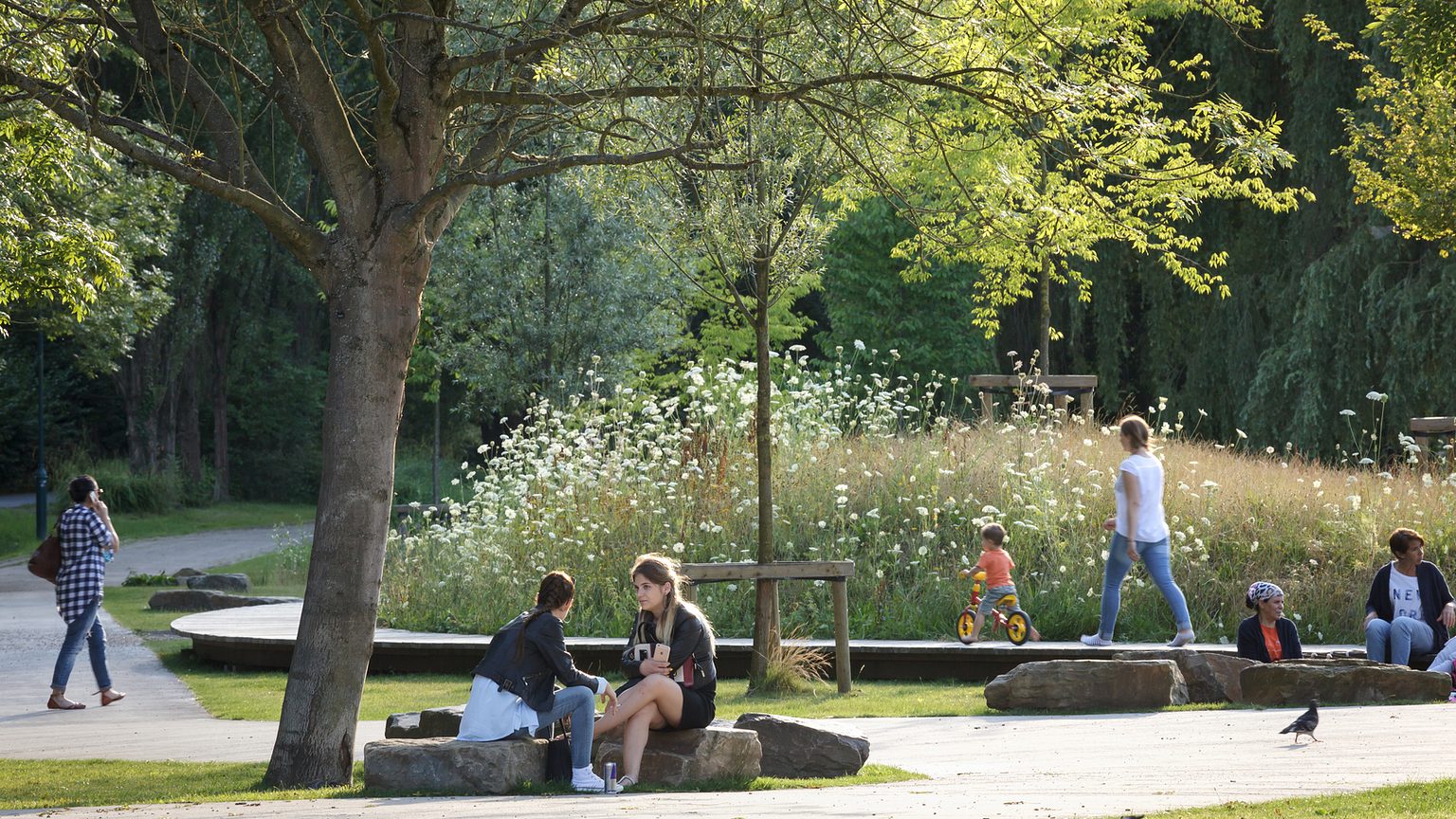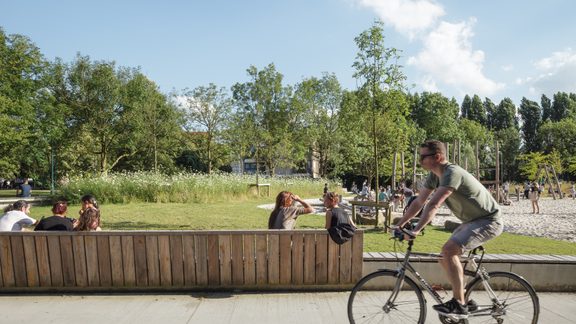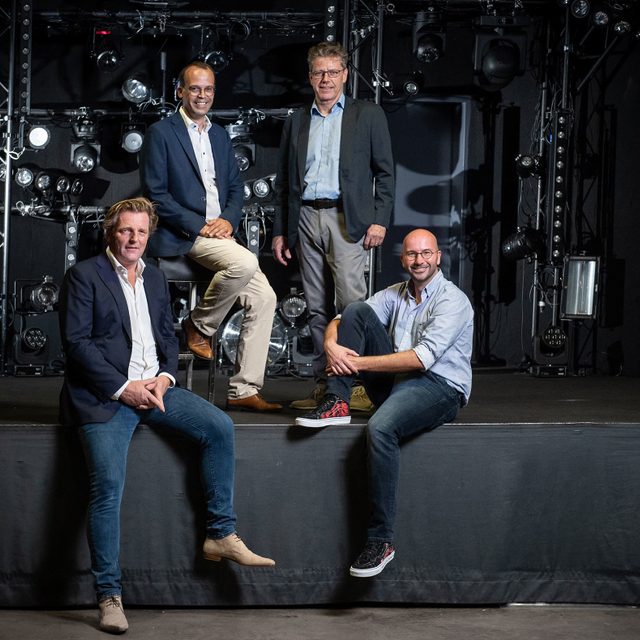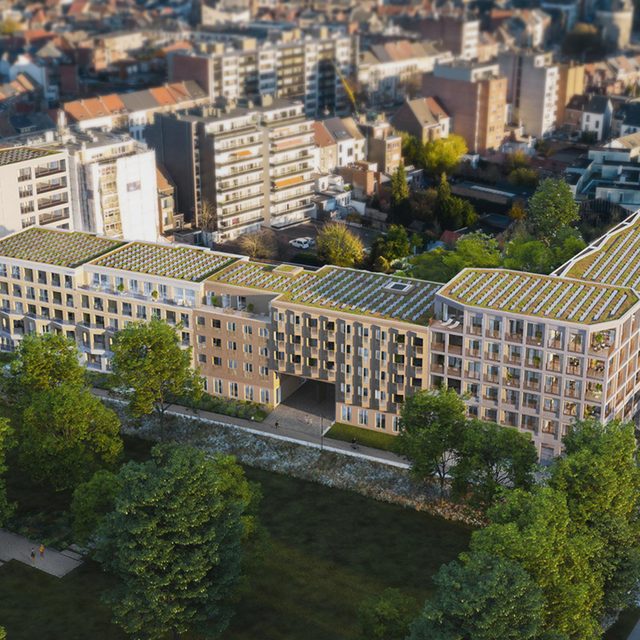
Living and spatial planning file: create a neighbourhood-level health strategy
About
Spatial planning as a tool for preventive healthcare. This is one of architect-engineer and urban planner Jens Aerts’ main focuses. Within the BUUR division of the engineering and architecture firm Sweco, he works with a range of partners on sustainable spatial planning. “We are holding important leverage in our hands”, he says. “With climate change and rising healthcare needs, smart spatial planning is more important than ever.”
Every sector has its policy plan, its structure, its funding. We need to build bridges, both horizontally and vertically.
Jens Aerts,
urban planner, division BUUR, part of Sweco
“Did you know that urban planning as a discipline stems from healthcare?”, asks Jens Aerts, at the start of the conversation. “During the cholera epidemic in London in the mid-19th century, Dr John Snow mapped out where the victims lived based on evidence. He detected outbreaks of infection and was able to identify the cause: poor water quality. Until that point, the government had put the responsibility on the individual: cholera was a matter of personal hygiene. This transpired to be untrue; it was in fact a matter of poor facilities. In the wake of this, the first urban planners set to work. They stressed the importance of ventilation in houses, good sewers and greenery in the city. The major fires in London also forced the government to engage in smarter urban planning and to impose standards.”
“Covid once again pushed our noses to the grindstone. We may have talked about social distancing, but actually we meant physical distancing: it was important to keep physical distance. For that, you need space. This includes public spaces and parks, where we can socialise while maintaining physical distance.”
“Open space is as important to urban planners as the built environment”, says Jens Aerts. “Preserving and making good use of the scarce space left to us is a priority. We often work on behalf of local authorities or regions, but we are sitting at the table with a wide variety of partners.”
“Social changes have a major impact on spatial planning. Climate change in particular is playing a role today. Both in terms of mitigation (slowing down and reducing climate change) and adaptation (timely adaptation to climate change). Climate change is in full swing and will continue over the coming years and decades. It affects our health, the way we live and the way we design space.”
Jens Aerts: "So by redesigning the space, we are not only working to improve air quality, but also encouraging people to walk, cycle, and to exercise more. Exercise is healthy, exercise works preventively"

Five key levers for a healthy environment
Climate change is forcing us to fill space differently. At the same time, another social phenomenon is at play: the continuing ageing population, resulting in a rising need for care. Can we tackle both evolutions together? “When it comes to healthcare, urban planners are thinking about prevention”, says Jens Aerts. “We have several angles for this. The Barcelona Institute for Global Health lists five spatial concerns. You can think of those as 'the medical prescriptions' that spatial planners get to work with.”
“The first issue is air quality. This is closely linked to the energy transition. Indeed, the fossil fuels that cause climate change are also disastrous for air quality. For a long time it was assumed that we should focus exclusively on the major centres, the ports, industry. Today, thanks in part to the citizen science research Curious Noses, we know that local solutions can also make a difference. Some streets score very poorly when it comes to air quality. By redesigning them and making them car-free, you get a healthier environment very quickly. Car-free neighbourhoods in Antwerp, Brussels and Ghent reduce the fine dust in the air we breathe.”
“Movement is the second focus. Take the Pentagon, the city centre in Brussels: one year after the introduction of the regional Good Move mobility plan; car usage there has decreased by 50%, while bicycle usage has increased by 30%. “So by redesigning the space, we are not only working to improve air quality, but also encouraging people to walk, cycle, and to exercise more. Exercise is healthy, exercise works preventively. So let’s make places everywhere that invite children, adults and the elderly to move: streets, parks, squares, and so on.”
“A third aspect is green space. Commissioned by the Flemish Care and Health Agency and the Department of Environment, Sweco investigated the relationship between green space and health. Based on this, we created a handbook for more green space. Flanders is considering introducing green standards. It is about quantity as well as quality. A grassy plain is not biodiverse and does not invite activities. A park with trees and plants, benches for the elderly, a playground for children and a place for young people, though, is qualitative. Another example: instead of constructing one big football pitch somewhere for a limited group, it would be better to opt for a smaller football pitch with additional activities. This way, we appeal to different target groups at the same time. Care facilities can also do their bit. I am thinking of the project we are developing with UZ Gent. The campus is surrounded by neighbourhoods, but the hospital itself is still a fenced-in area where you only come when you are sick. We are making UZ Gent into an open campus, where people from the neighbourhood can also use the public space.”
“A fourth issue is sound quality. Noise pollution causes stress and sleepless nights, which puts a strain on mental health. It is not obvious to reduce noise in densely populated areas with many activities. Despite this, standards are emerging in that area too. This means we are seeing more and more sound barriers or screens along railway lines. Places of silence are also coming into vogue.”
“A fifth and final lever is temperature. We are experiencing more heat waves and higher peaks. Older people and young children in particular can fall victim to this. Again, more greenery is a solution. A green street is 3 to 4 degrees Celsius cooler than an ordinary tarmac road. Evolution is in full swing. In the Brussels region, you will soon be allowed to reserve a maximum of 50% of the space for cars in order to get an urban planning permit. This way, you guarantee that there is room for greenery. 10% of the space should also be softened, both for the trees and for better water management.”

New residential care concepts
“Using those five tools, we can make a difference, including towards the aging population. I believe in the concept of assisted living neighbourhoods, in which different residential and learning functions come together with good accessibility. We need to focus on more collectivity and intergenerational solutions. On removing partitions, for example with a residential care centre and a day nursery in one concept. We need to provide transitional housing for older people who are still mobile. Attention to self-reliance and prevention are needed.”
“We need to focus on more collectivity and intergenerational solutions.
“With new residential care concepts in healthy, liveable village centres where it is pleasant to live and everything is accessible - think bakery, local shop, GP - we are creating an alternative to assisted living. Care facilities can respond to this. For example, why not have a healthy food shop in a hospital? Or a primary health centre with a neighbourhood restaurant, a nursery and a hall for all kinds of activities in one building. If we can realise those kinds of linking opportunities, we will succeed in keeping people living at home longer.”
Jens: "Every sector has its policy plan, its structure, its funding. We need to build bridges, both horizontally and vertically.”
“One issue is that each sector is highly specialised and not yet multidisciplinary enough. Every sector has its policy plan, its structure, its funding. We need to build bridges, both horizontally and vertically. Spatial planning mainly takes place in the municipalities, where permits are granted. But healthcare is mostly federal. How can we align this better, including horizontal alignment? The spatial planning discipline has somewhat lost sight of the healthcare aspect. We focused mainly on economic development and sustainability. But ever since Covid, a healthy environment is coming back into focus.”
“Health policy itself focuses too much on the curative aspect. A positive factor, therefore, is the creation of the Prevention Platform: an initiative of several key figures from the healthcare sector and academia, including Margot Cloet of Zorgnet-Icuro. As a spatial planning expert, I am also involved in that. It is an informal network with a memorandum advocating strong preventive health policies. Not only with screenings against colon cancer or campaigns against smoking, but also with the five urban planning levers. We can avoid a range of health problems through better air quality, more greenery and more exercise.”

District-level health strategy
“Every neighbourhood should have a health identity card”, says Jens Aerts. “How is the neighbourhood functioning? What problems does it present? What facilities are available? You could use the anonymised data from the health insurance funds to create a health atlas by district. And on that basis, work with various disciplines - health care, spatial planning, local government, mobility and so on - together to devise a strategy for each neighbourhood. Is anything missing? How can we address the issues? Is more greenery needed? More softening? A hiking network? A community health centre?”
“Things are already moving. Consider the Flemish government's Green Deal on Sustainable Care, on which we are collaborating with Sweco and many partners. At the same time, we are noticing that subsidy mechanisms are often not yet adapted to the new needs. For example, care facilities are funded for the new construction or renovation of buildings, but not for the green environment, for good mobility, for neighbourhood-level initiatives... This attention to outdoor space has yet to penetrate the funding. There is still a major challenge there.”
“Flanders is still not taking spatial planning sufficiently into account as a strong, guiding strategy for preventive healthcare”
“Flanders is still not taking spatial planning sufficiently into account as a strong, guiding strategy for preventive healthcare. We are often not involved in specific files and projects until the broad outlines are already established and planning permission is required. This has to change. We advocate sitting down with an urban planner at the beginning of every construction project for a short, smart exercise from various perspectives. After all, it's never just about the building, but always about the environment and the opportunities there for greater health and a more cohesive society.”
TEXT: FILIP DECRUYNAERE
IMAGE: TINI CLEEMPUT
@Zorgwijzer
Other interesting articles

EKOplan joins Betic Ingénieurs-Conseils, subsidiary of VK architects+engineers in Luxembourg

Sustainability reporting: an opportunity to realise new profits
